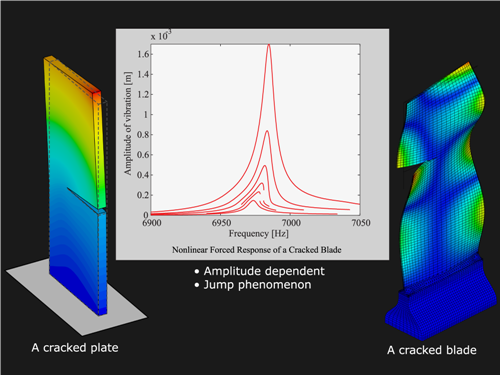Nonlinear Vibration Analysis of Cracked Structures
The dynamics of cracked structures
feature non-smooth nonlinearity due to the repetitive opening and
closing of the crack faces. Accurate prediction of resonant
frequencies and response shapes of such structures is very
important for practical applications such as damage detection and
structural health monitoring. However, traditional linear and
nonlinear vibration analysis tools that are typically employed
with FE models fail to accurately predict such phenomena. In our
research, highly efficient and accurate methods have been
developed for predicting such phenomena, and successfully applied
to problems with realistic complexity, such as turbine engine
blades with cracks. We also develop models which account for
fluid-structure interactions which affect localization and
high-cycle fatigue.

Vibration Analysis of Multi-stage Turbine Engine Rotors
Turbine engine rotors have multiple
stages of bladed disks without special symmetry. Vibration of
stages is fully coupled and shows complicated dynamics. In our
research, characteristics of such phenomena have been
investigated, and an efficient computational method has been
developed for model-based vibration prediction. The method uses
only a single segment per stage and enables us to predict the
vibration response of the entire multi-stage turbine engine
rotors.

Nonlinear Parametric Reduced Order Models
Structural analyses based on finite
element models (FEMs) are often used to predict vibration
responses, stresses, and other structural characteristics to
support design processes. As computing power increases, numerical
simulations continue to replace experiments for testing new
designs. However, the complexity of the designs can make the
computational analysis very slow when many component changes are
needed during the design process. This issue is particularly
important in industrial FEMs which require extremely accurate
structural response data, and therefore contain millions of
degrees of freedom (DOFs). The large computational cost of direct
analyses on these large FEMs detrimentally affects the design
cycle, especially when it is necessary to evaluate the effects of
parametric variability and damages on the structural response.
Additionally, when the structure has a crack, it is well known
that system-level response characteristics of cracked structures
differ from their healthy counterparts. In general, a nonlinear
analysis is needed to predict the vibration response of a cracked
structure because the periodic opening and closing of the crack
surfaces leads to a nonlinear response. This nonlinear analysis is
complex and is computationally expensive. To alleviate these
issues, we developed efficient approaches for reduced order
modeling of complex cracked structures such as parametric reduced
order models (PROMs), component mode synthesis with static mode
compensation (SMC-CMS), bilinear frequency approximation (BFA),
and bilinear mode approximation (BMA).
PROMs have been developed for fast reanalysis in the presence of
structural variations. These models are able to handle
simultaneously with very high efficiency both parametric
variability and damage. In addition, for geometric variations
(dents), the SMC-CMS has been developed. For SMC-CMS, a set of
basis vectors can be established using a combination of normal
modes of the pristine structure compensated by static modes. The
key advantage of SMC-CMS is when the dent shapes are changed,
normal modes of the dented structure do not need to be
reconstructed because the normal mode is easily obtained by
calculating the static mode from the new dent. Furthermore, for
the cracked structure analysis, BFA and BMA have been developed.
Although the generalized BFA and BMA cannot capture the effects of
gradual opening and closing of the cracks, they can provide
excellent approximate values for the resonant frequencies and
response of complex cracked structures. The BFA and BMA are linear
analyses, so the calculation time to obtain the dynamic response
of cracked structures is much less than that of the nonlinear
analyses.

|

